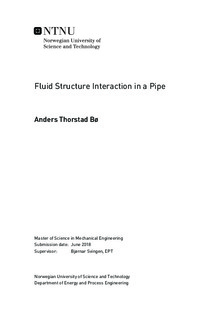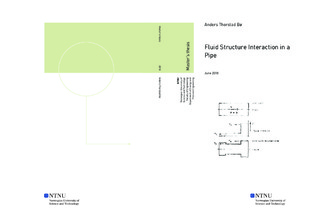| dc.description.abstract | One of the recurring challenges concerning the development of fluid piping systems, is making them suitable for the task at hand. The system has to withstand all possible forces and motions associated with everyday use, as well as from more catastrophic one-time events. Nowadays, research efforts are being made to investigate how flexible power generation can be used to supplement other renewable, more unpredictable power sources like the wind and sun. Through this research, the need for hydraulic systems that are able to withstand several consecutive and rapid start-ups and shut-downs during a day becomes evident. Accurately depicting and studying these complex, transient events are more demanding, both computationally and experimentally, giving the need for specialized mathematical models and more task-specific instrumentation. Through project work during the fall of 2017 the candidate has made a computer program that simulates the fluid-structure interaction (FSI) in a liquid-filled, straight pipe. The mathematical model, the so-called extended waterhammer equations, are transformed with the method of characteristics (MOC), resulting in a numerical model capable of achieving an almost analytical solution to the set of equations.
The objective of this master s thesis is to conduct laboratory experiments with the aim of validating the calculations and verifying the theoretical background leading to the extended waterhammer equations. The experiments were conducted using an existing test-rig at the Waterpower Laboratory at NTNU. The transient measurements were done using miniature pressure transducers and linear strain gages placed at four different locations along the pipe length. All output signals from the rig were logged by a specialized program made with LabVIEW, and further processed in the programming language Python.
The results verifies the presence of the Poisson and junction coupling in the physical experiments. The validation process are more inconclusive, but the predictions are able to yield similar amplitude and wave propagation velocities as the measurement data in the first $0.5$ seconds, but severely underestimates the first pressure and strain peak. Inaccuracies in the boundary condition-modeling and the forming of vapor cavities in the experimental rig are suspected to be among of the reasons why predictions fail to reproduce the measured system response. | |

